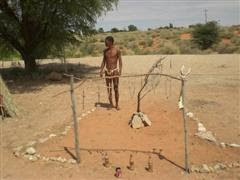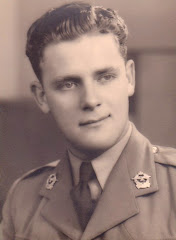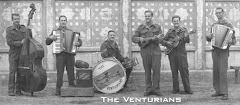Once upon a time, when South African Airways was considered to be one of the finest in the world, I lived in South Africa, near to a brand new airport. I was very proud of that airport — not only because my dashing young genius of a husband was involved in setting up the state-of-the-art Instrument Department, but also because the airport was very appropriately to be named for a very important man, none other than Field Marshall Smuts, the venerated South African hero, and two other world-famous men were to be permanently associated with it.
"Monty"
The airport was dedicated by an illustrious British military commander, Bernard Law Montgomery, who was the Allied hero during World War II who beat Germany's Erwin Rommel in the battle for North Africa, and by the end of the war had been made First Viscount Montgomery of Alamein (1946). I could not yet have been in secondary school when I first heard the name of Field Marshall Bernard Montgomery, the hero of El Alamein and North Africa, and I had to grow up a little more in order to appreciate why it was said that “Monty” had proved to be one of the most inspirational military commanders of World War Two. He was also the senior British military commander at D-Day, and retained that position within the west European sphere of the war until the war ended.
Born in 1887, he gained an early commission in the Royal Warwickshire Regiment, and during World War One served on the Western Front. A highly efficient young officer, he was given a succession of command posts both in Britain and in India, and by 1938, he had been promoted to the rank of major-general. In 1939, at the outbreak of World War Two, Montgomery was part of the British Expeditionary Force that had to withstand the might of the Wehrmacht’s "Blitzkrieg" and in due course he would be given the command of the Third Division (BEF), which had to be evacuated at Dunkirk.
I was not too young to be swept up in the anxiety our entire county endured at the time of El Alamein. In addition to students in my class at school who had been evacuated from Britain to South Africa, and who could too often called to the principal’s office to be told the bad news about a father or a brother, my sister, ten years older than I, had friends who were maimed, killed, or “went into the bag” (taken prisoner), and no one in South Africa would deny that Monty’s victory at El Alamein turned the tide of the war. After their defeat at El Alamein, the first the Germans had experienced, they could only retreat, and they left North Africa in May 1943.
The Statues in the Foyer – Sir Pierre van Rynevld and Sir Quentin Brand
Upon entering our fine new airport, travelers were met by statues of the country’s two most distinguished flyers, Sir Pierre van Rynevld DSO, MC, and Sir Quintin Brand DSO. Hesperus Andrias Van Ryneveld (better known by his friends as “Pierre” and, by my parents, as “Pierrie") and his brother before him had both, successively, been connected with the Royal Air Force from the day it was born on 1 April 1918, and in time Pierre was to become one of the two pioneer aviators who made the first flight from Britain to South Africa. After the war, he was called back to South Africa by Prime Minister Smuts in order to set up a South African Air Force.
He flew back home, across Africa, in a Vickers Vimy — a pioneering feat for which he and his co-pilot Quintin Brand were both knighted. On 14 May 1920, the then Lieutenant-Colonel Van Ryneveld, late Royal Air Force, was appointed a Knight Commander of the Order of the British Empire in recognition of the valuable services rendered to aviation by the successful flight from England to Cape Town.
It was Smuts who had wanted South African aviators to be the first to complete the trip from London to South Africa, and who had authorized the purchase of a Vickers Vimy at a cost of £4,500. It was named the Silver Queen, and commanded by Lt Col van Ryneveld with First Lt Quentin Brand, later Sir Christopher Quintin Brand, as the co-pilot. The latter had served with distinction in the Royal Flying Corps and the Royal Air Force in World War One, and destroyed a German Gotha bomber in the last air raid carried out on the United Kingdom in that war.
My Mother and the "Air Ace" — A Cherished Memory
My father and Pierre van Ryneveld — who was to establish the South African Air Force in 1920 and direct it until 1933, when he was promoted to Chief of the General Staff (CGS) in command of the Union Defense Forces — had remained close friends throughout their school days at Grey College in Bloemfontein, after which Van Ryneveld had taken to the sky and my father to the pursuit of law and accounting.
By the time Pierre had become a legend, my father had married my mother and become the Mayor of Theunissen, a small town in the Orange Free State. Because I was not yet born, I can't be precise about whether it was to please my father or the citizens of the town, but I would often hear the story of how, not long after arriving back in South Africa after the epic flight, the great man flew his famous plane to Theunissen, where my mother was to have the honor of greeting him and hanging a laurel wreath about his neck.
I can just picture the excitement and the preparations... Choosing the right hat and gloves (essential in those days), getting the hair "just right," etc. etc., and then managing to retain a vestige of poise as she clambered (with as much dignity as she could muster) into the Mayoral limousine (probably a Model T) to go and join my father at the airfield. When, after some delay, the car finally arrived, the driver turned the ignition key in the lock, only to find –- to everyone's dismay — that the engine just would not start! No amount of tinkering would do the trick, so finally, as a last resort, a policeman who rode a motorcycle was summoned to convey my mother in his side-car.
Across bumpy, recently ploughed fields, and finally across the rough terrain of the open "veld" they went, my mother holding on for dear life and sending up fervent prayers of gratitude for the fact that it was the custom, when 'ladies' went for a drive, for them to wear a face veil.
In the end it all turned out better than expected. The guest of honor was charming and surprisingly modest, and everyone went home well-satisfied after watching Sir Pierre's plane disappear into the clouds once more. But the story does not end there.
A School Named Sir Pierre van Ryneveld
Many years later, in the late 1970's if memory serves me correctly, when my mother was already in her 70s, a new High School was established in the city of Kempton Park (which is actually where the Johannesburg Airport is situated). It had been decided that this school should bear the name of Sir Pierre van Ryneveld, and my mother, who was invited to be present at the landing, had the thrill of seeing her old friend descend from the sky once more — this time in a helicopter!
There was a to be a banquet in his honor that night, to which mayors and other dignitaries from along the Wiwatersrand had been invited, and when my mother also received an invitation to attend, she seemed at first to be delighted, but, to our concern, also appeared to become increasingly agitated.
"Of course I can't go," she wailed, when questioned... "Everyone else will be arriving in chauffeur-driven limousines, and how on earth am I supposed to keep up with them?"
Well, you would have to know about the unique “in-law” bond that existed between my mother and her son-in-law. In fact, I think she often wished that he could rather have been the real offspring, for she adored him, was inordinately proud of him, always sided with him, and openly commiserated with him for getting such a raw deal in marrying me! Be that as it may, he could never bear to see her disappointed or dejected; so, as he had just acquired a brand-new Jaguar XJ6, he put on his tux, seated her in the back of it, and drove her to the banquet in style. He dined with the official "chauffeurs" down in the basement, and later declared the meal to have been one of the best he had even eaten.
Long Gone Are Those Days of Glory, and No One Seems to Care!
Returning to South Africa recently, to do research for a book set in the Kalahari, I was surprised to find that that airport was no longer named after Jan Smuts, and I was disappointed when I was unable to find the famous statues which I had looked forward to seeing again. When I inquired, no one at the airport seemed to know what I was talking about.
Ever since my return to Canada, I have tried, even via Facebook,seeking the assistance of some of my former students who have since become flight attendants, but none could recall seeing the statues, either. Determined not to give up, I finally wrote to South African Airways, asking where the statues of Sir Pierre and Sir Quentin Brand could be seen — only to receive the most unexpected response. They could not be reached, I was informed, unless I could specify the departments "in which they are employed!"














.png)







.jpg)









3 comments:
What the heck is this guy rambling on about? What's it got to do with the article whicvh, by the way is excellent!
very nice article. I am doing some research concerning Sir Pierre van Ryneveld. He is my great uncle.
Warren Lehmensich
Lastly, you should know that the online therapist finder is really
appropriate. Remember that you are usually limited to a number of sessions so you might
want to consider paying out of your own pocket.
Insurance companies also demand certification and in that
case the individual is considered disqualified from engaging
in clinical practice if not certified.
My blog post :: dictionary meaning of depression
Post a Comment